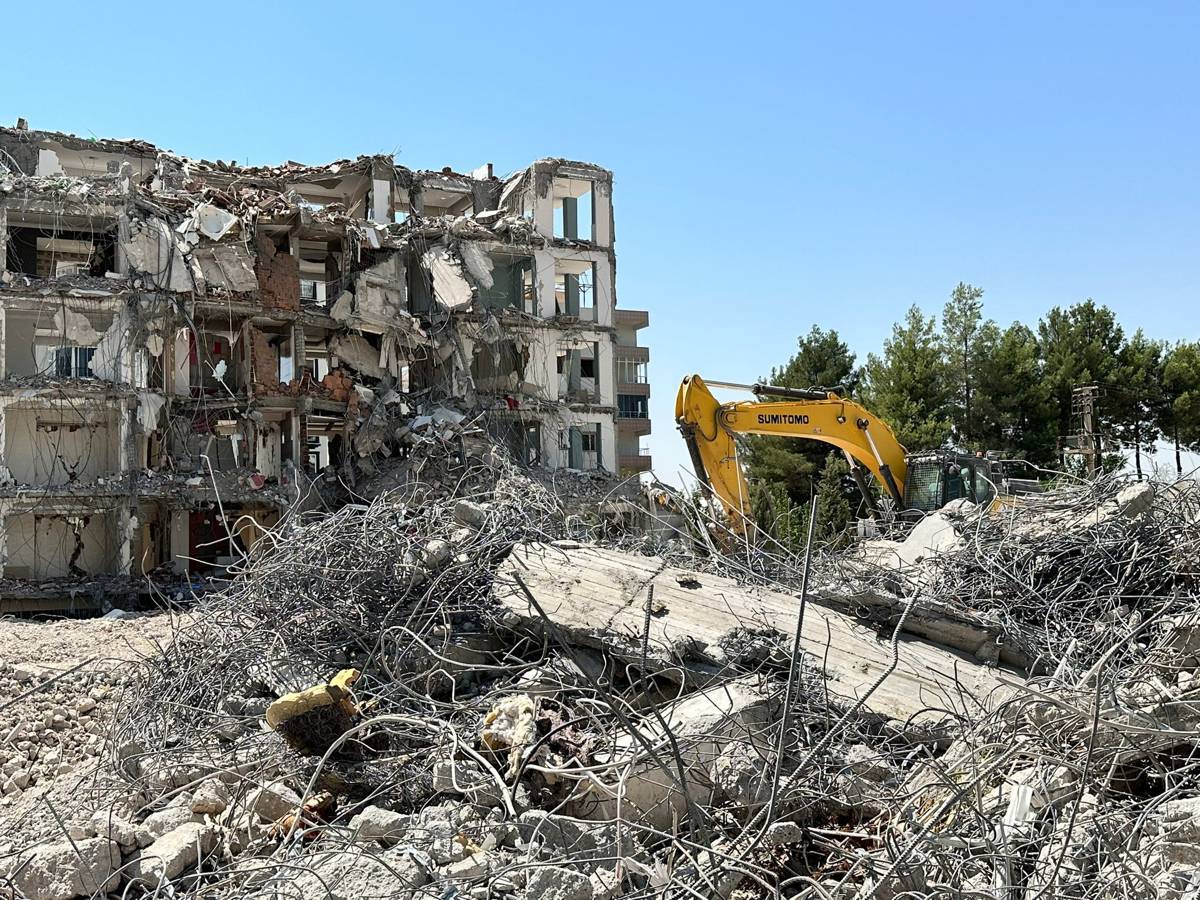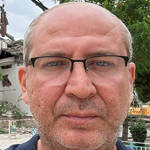Challenges persist in Adıyaman 10 months after quakes


In Adıyaman, 5,953 buildings collapsed in the February earthquakes, leaving tens of thousands homeless. The city, with a total of 20,201 heavily damaged buildings, is still undergoing debris removal efforts. The remnants of collapsed buildings and those awaiting demolition create a haunting scene at various points across the city. Debris removal operations and frequently closed roads particularly impact both vehicle and pedestrian traffic adversely.
A significant portion of earthquake victims are sheltered in container cities, while others, if financially able, have rented houses near their relatives.
Survivors in despair
Those affected by the earthquake are unhappy and hopeless due to the challenges they face. Those relocated from tents to container cities are waiting for the day when they can resume normal life in a house, expecting promises made to be fulfilled.
One earthquake survivor articulates their experience, saying, "Transportation is a challenge in this town. We live in container cities outside the city and pay a fortune for transportation. Due to economic difficulties, our daughters, who should go to school, work along with us to bring bread to the table. We cannot benefit from health services as we wish; there are no doctors in hospitals, and we cannot get appointments. We demand a solution to this situation."
Growing unemployment and migration issues
The economic difficulties experienced nationwide have a more profound impact on earthquake victims in Adıyaman. High rents and unemployment exacerbate the city's problems. Adıyaman Chamber of Commerce and Industry (ATSO) Assembly President Gani Bereket highlights the increasing shortage of skilled workers, accompanied by the migration that started in the city.
He remarks, "Immediately after the earthquake, an incredible migration began. Almost everyone abandoned Adıyaman. Especially educated and skilled professionals left. Only those dependent on the state and our citizens with green cards remained, and most of them do not have a profession. Considering migrations, unemployment, and all the problems faced by capital, our city, at this rate, will become a village with a governor.”
Bereket emphasizes the shortage of skilled workers in almost every sector in Adıyaman:
There are very few houses for people to live in. If you need to renovate houses that are not demolished or lightly damaged, you cannot find a skilled worker. Even if you find one, you are obliged to pay 1500-2000 liras for a job that should cost 100 liras. Of course, if you find a craftsman, you are considered lucky. Our industrialists are troubled. Unable to find employees to hire, the economic conditions within the sector are putting them in a difficult position. Industrialists, unable to pay salaries to their employees, are either downsizing or considering closure. The first six months of 2024 seem to show us what will happen. We have no hope or strength left. Nobody can find the money to rebuild their collapsed businesses."
According to Bereket, those employed under the status of Personnel Working for the Public Benefit (TYP) by the state exacerbate unemployment, stating, "Currently, there are tens of thousands of people working as TYP in Adıyaman. All these citizens receive the minimum wage. Age does not matter; people of all ages can enter the workforce as TYP. In this situation, businesses, including bakers, markets, and the textile sector, cannot find employees." He concludes, "Everyone registered with İŞKUR is idle at home, waiting for a job in the TYP cadre."
Bereket adds, "There is no infrastructure, no superstructure, roads are riddled with holes, and people can no longer find sidewalks and roads to walk on. Every problem we experience in this city, from educational issues to health problems, is simultaneously a violation of rights and a humanitarian tragedy. We do not deserve this.
“The beautiful and esteemed people of this city deserve the best of everything, but we are all victims, including myself. My workplace is destroyed, I have a container shop. My warehouses collapsed, and I have gone beyond material damage, but I did not leave my city to serve."
Rebuilding is not easy
Adıyaman Mayor Dr. Süleyman Kılınç acknowledges the challenging task of rebuilding the city:
In Adıyaman province and central villages, 2,546 buildings were destroyed. Urgently needed for demolition and demolished, 1,005, heavily damaged 8,153, moderately damaged 10,405, lightly damaged 19,725, and the total number of buildings is 44,818."
In this earthquake, which we call the disaster of the century, our infrastructure and water network were also damaged, not just the superstructures. Currently, we are changing the infrastructure, replacing 700 km of the first drinking water pipeline completely. We also have an application to the municipal bank for the separation of rainwater and sewer lines and additional waste treatment facilities, which has been accepted as a grant. The process will hopefully begin soon. On the other hand, the construction of damaged roads and sidewalks continues.
To restore the city to its normal appearance and provide citizens with spaces where they can breathe freely and spend quality time, we are creating numerous large park areas—some of which are already in operation. We are also restoring historical mansions and developing projects for the construction of buildings in the urban transformation area that reflect neighborhood culture and evoke its old texture. Local zoning changes are being made to further widen roads and streets. We are working on a Transportation Master Plan, monitoring the licensing process for moderately damaged buildings, providing zoning permits for on-site transformation, and other locations. Our social aid efforts continue without interruption. Social markets, electric vehicles, basic necessities, financial aid, etc., are being provided. Our cultural, artistic, and educational activities for our youth and children persist, and vocational training courses for women continue at the Women's Youth Center.
Meanwhile, traditional municipal services are ongoing. Additionally, the construction of the Disability-Friendly Living Center is underway. The new municipal building and slaughterhouse are in the tender process, while the Animal Hospital and Shelter are in the final stages of site acquisition. Hopefully, we will complete all of these projects as soon as possible. There is currently no issue with our drinking water, and no diseases are related to it. Water tests show levels as of February 6 are consistent, and daily tests are conducted. Of course, our people continue to live and cling to life, burying their pains within.
Abdullah Akbaş, the President of the Adıyaman Chamber of Architects, begins his speech with the words, "In Adıyaman, a kind of large-scale tragedy occurred. We lost thousands of our citizens after the earthquake. On February 6, 2023, at 4:17, time seemed to stop in Turkey."
Akbaş continues, "Although about ten and a half months have passed, the demolition of heavily damaged buildings is still ongoing. The method used in the demolition process causes discomfort in the city, where the demolition of heavily damaged buildings progresses slowly. The separation process in the demolished buildings continues to be done on-site, leading to environmental pollution threatening health.
“Despite emerging from such a massive disaster, we are not prepared for a possible new earthquake. The psychology of the community in Adıyaman collapsed after the earthquake. There is a significant increase in the cost of living in the city. Opportunists have emerged, making life difficult in the city. Especially construction materials and labor are very expensive. About 68% of the city has been damaged. Without the help of the state, it will take a long time for recovery."
Biggest challenge: shelter
He goes on to say:
There is nothing to say about houses built on solid ground, but there are deficiencies. There is no unifying axis between the city center and newly constructed houses. So far, no action has been taken on this matter. Urgent planning is required. If we cannot connect the new settlement area with the city center, these areas will eventually become empty and people return to the center. Newly built houses will remain as idle spaces unless unifying structures are quickly combined with social facilities.
Approximately 307,000 people have left Adıyaman. These are the deceased and those who have migrated from Adıyaman. This situation has caused a serious population loss.
To lift Adıyaman again, we did not leave our city. We aim to plan Adıyaman again, put our hands under the stone, and make it a better city than before in the destroyed city. Hopefully, we will not experience such dreadful days again.
Current situation
According to information obtained from official sources, after the earthquakes on February 6, the number of collapsed buildings in Adıyaman province was 5,953, and the number of heavily damaged buildings was 20,201, with the debris of heavily damaged buildings removed at a rate of 81%.
The number of buildings in court proceedings preventing demolition is 3,411, and the number of culturally valuable structures with severe damage is 19 according to official records. The rate of removal of debris based on volume (m³) is 89%.
After the earthquake in Adıyaman, the number of people who moved to containers and prefabricated buildings in the province is 112,905. In the city and district centers, 66,514 citizens are accommodated in 22,225 containers; additionally, in rural containers, 46,391 people are accommodated in 11,760 containers. In the entire province, a total of 33,985 containers/prefabricated structures house 112,905 people.
The total number of houses to be built in Adıyaman province after the earthquake is 41,324, and the construction of permanent residences is ongoing.
As part of of in-place transformation works in the province, 22,185 earthquake victims applied. So far, only 9 people have been granted permits, and construction permit certificates have been issued to 65 people. (FB/Mİ/VK)





